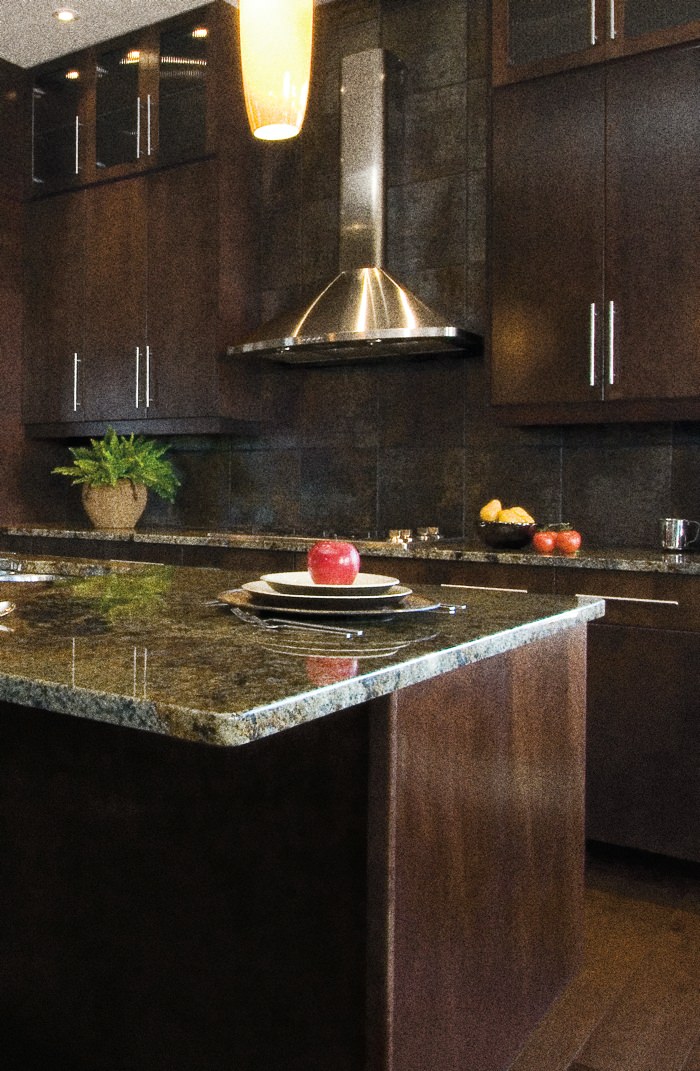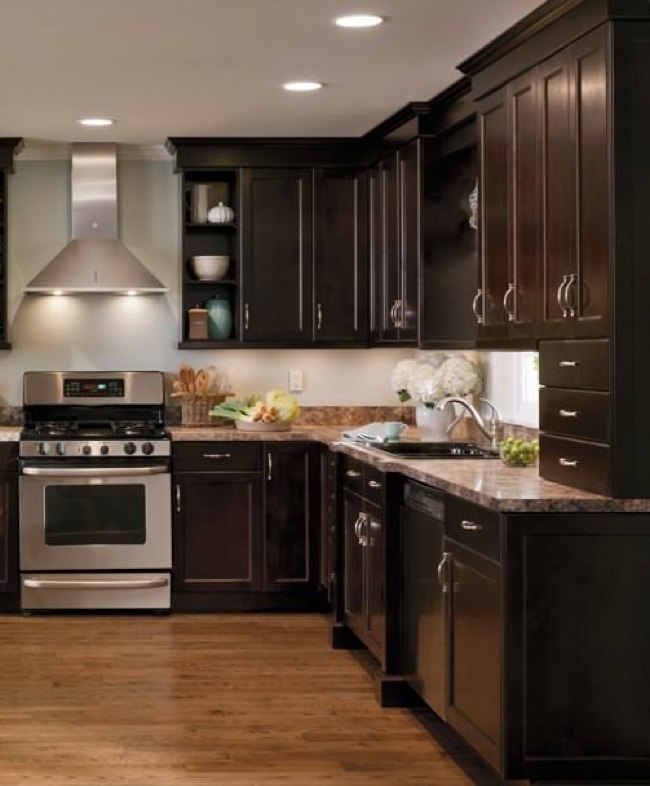The Kitchen is the Heart of the Home – Keep it Clean!
After your new kitchen has been built, you can use these cleaning tips to help you keep your cabinets and countertops functioning properly and looking brand new. You’ve dedicated a lot of time into your investment, so it’s only natural that you’ll want to make it last as long as possible so that you can enjoy it for many years to come.
In this article you’ll find 14 trusty cleaning tips and advice on the right cleaning products to use when cleaning your kitchen cabinets and countertops. Make sure to read each section carefully so you don’t accidentally damage them.
Sections in this document:
- Cleaning Your Countertops
- Cleaning Your Cabinets

Cleaning Your Countertops
Countertops come in a wide variety of materials, and each type needs specific care and maintenance to not only get as clean as possible, but also to avoid damaging the surface.
Wood
Wood or butcher block countertops are very elegant, but the material is also soft and can be easily stained if you’re not careful. To effectively clean wood countertops of everyday dirt and grime, mix some warm water with a quarter cup of white vinegar. Spray the solution on the countertop and wipe it with a soft cloth or sponge.
To remove stains, rub lemon juice and salt into the stain and wipe it away with a wet cloth. Tougher stains may require sanding the surface of the countertop, but it’s best to avoid this as much as possible since sanding removes the finish on the wood and may damage the surface.
If you sand the stain away, you’ll need to apply lacquer to the surface afterwards to restore the protective barrier.
Laminate
One of the best features of laminate countertops is that they are extremely easy to clean. Cleaning laminate countertops requires a simple combination of liquid soap and water. Once clean, wipe down the surface with a damp cloth to remove any excess soap.
To remove stains, mix baking soda and water into a paste and gently apply the mixture to the stain without scrubbing it. Baking soda is abrasive, and scrubbing it into the surface will damage the laminate. Let it sit for five to ten minutes, depending on the severity of the stain. Gently remove the paste with a clean wet cloth.
Tile
Ceramic and porcelain tile is very resistant to grime, but the grout can trap crumbs, dust and other debris very easily. The tile itself can be cleaned with any household kitchen or bathroom cleaner as long as the chemicals aren’t harsh.
Grout and finishes can sometimes be broken down by harsh chemicals.
In order to clean the grout, mix a tablespoon of bleach with two cups of water and either put it in a spray bottle or leave it in a cup. Use a soft-bristled toothbrush and scrub the bleach solution into the grout.
Marble
Marble is one of the most gorgeous countertop materials you can find, but it’s also easily damaged and stained if you’re not careful when cleaning it.
Luckily, it’s also easily cleaned. Simply clean the surface with some mild soap, water and a soft cloth. Wipe away the soap residue with a clean damp rag. Never use acidic solutions such as mixtures made with lemon or vinegar since the acid can damage the surface.
Like laminate countertops, a mixture of baking soda and water can eliminate most stains, but you’ll have to wait around 24 hours for this technique to work effectively on marble.
Granite
Another unique and beautiful countertop material is granite. While granite is also commonly cleaned with soap and water, it’s not the most effective option for this stone. There are non-acidic stone cleaners that are perfect for cleaning granite countertops, but a simple half-and-half mixture of rubbing alcohol and water applied with a sponge will effectively clean and disinfect the surface.
Stainless Steel
Stainless steel not only looks sleek and professional, but it’s also extremely practical since it’s so easy to clean. Any common household cleaner is effective at cleaning stainless steel, but you can also get good results with mixtures of either baking soda or dish soap with water.
Never use rough cloths or scouring pads since stainless steel is extremely susceptible to scratches.
Cleaning Your Cabinets
 Cabinets are magnets for all of the moisture, dirt, grease and grime that gets spread around in your kitchen. Luckily, almost all cabinets are made out of wood, which makes it easier to establish a more universal set of cleaning tips for them.
Cabinets are magnets for all of the moisture, dirt, grease and grime that gets spread around in your kitchen. Luckily, almost all cabinets are made out of wood, which makes it easier to establish a more universal set of cleaning tips for them.
For Dust and Everyday Grime, Use Vinegar and Water
A kitchen that only gets light use will typically only need a quick wipe down on occasion to get rid of dust and other common debris.
A half-and-half mixture of vinegar and water applied to the surface and wiped away with a cloth will clean the cabinets thoroughly.
This mixture is also effective on any metal hardware that is on your cabinets such as knobs, handles and hinges. To clean these pieces, use a soft-bristled toothbrush.
For Grease and Dried-On Grime, Use Goo Gone or Baking Soda
Goo Gone is a great product to get rid of sticky and greasy substances that may be on your cabinets. Simply apply it to the grease or grime, wait three to five minutes and remove with a dry cloth. To remove any excess Goo Gone, wipe the surface with a clean cloth, soap and warm water.
A mixture of one part baking soda and two parts warm water applied with a soft sponge is also very effective in removing grease and other dried-on grime from cabinets.
Cabinets with Glass Fronts
If your cabinets have glass-fronts, wipe them clean with any streak-free window cleaner. Don’t spray the window cleaner on the cabinets themselves since the chemicals might damage the wood. Instead, spray the cleaner onto a dry cloth.
Use Orange Oil Cleaners
Orange oil cleaners are incredibly popular since they not only remove grease and grime from wood cabinets, but they also create a spectacular sheen to the surface and act as a great deodorizer.
Simply spray a moderate amount of the cleaner onto the cabinets, wait five to ten minutes and then wipe the cleaner off with a soft cloth.
Avoid Saturation
Wood is very porous, and it can easily be damaged with liquids if it is soaked or the cleaner is left on the surface for too long. Getting your cabinets drenched in liquid may also cause your hardware to rust.
Painted Cabinets
The most commonly used paints for cabinets are usually very durable and will stand up to regular cleaning with all-purpose cleaners without any issue. Like unpainted wood, stains can also be removed with baking soda and water.
The only thing to be wary of when dealing with painted cabinets is latex paint. Unlike other paints, latex paint will easily scratch when scrubbed and it reacts poorly to abrasive cleaners such as baking soda.
Cabinet Interior Cleaning
The inside of your cabinets also need periodic cleaning. Remove all of the contents of the cabinet and use a vacuum with a soft brush attachment to vacuum out the shelves. If you have a liner on the shelves and it is stained or discoloured, it’s a good idea to replace it too.
Clean the shelves with a light spray of soap and water and wipe any excess soap residue off with a cloth. If the contents of the cabinet were dirty, wipe them clean before replacing them in the cabinet to avoid ruining the clean interior.